Error processing SSI file
|
Mission Blog: Sept. 24, 2009
Chelsea Lowes, Onboard Cruise Log Coordinator
Knauss Sea Grant Fellow, NOAA Ecosystem Research Program
Another successful day of diving complete! By today's end, we'll have completed 21 out of our 30 permanent sites! Talk about being on a roll! No problems to even speak of - knock on wood!
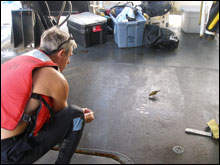 |
| John Burke offering the resident ovenbird water. (Photo: NOAA CCFHR) |
One of the teams came back reporting a dolphin sighting, so everyone has been on the lookout! We also have a couple of visitors onboard now - specifically a little ovenbird that must be exhausted from his long migration and seems to be enjoying the attention from the scientists!
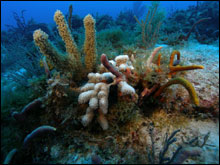 |
| Camera lights reveal colors of corals, sponges, and seaweeds. (Photo: NOAA CCFHR) |
Taking pictures underwater is very different than taking them on land. Not only do you have to deal with the actual being underwater part - you often have to account for the loss of light and color as you descend to deeper depths. In water, light is absorbed differently as you go deeper in the water column. The first color that gets absorbed is red, then orange, then yellow and on down the light spectrum until only blue remains unabsorbed - which is why many of our pictures appear to be all shades of blue! This is why, when taking underwater photographs, it is important to have another source of light if you want to capture actual colors. Our divers have a special set up that includes a waterproof case (the most important piece!), and two underwater video lights. These lights are attached to the camera via long adjustable arms and are on constantly - unlike a flash on a regular camera. These features allow the habitat photographer to adjust the lighting until the light is evenly distributed across the frame. This may sound easy, but when dealing with habitat that is several meters in height and covered in different textures, the skill of the habitat photographers comes into play.
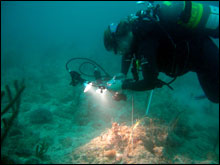 |
| Susie Holst taking habitat pictures - over 100 feet deep. (Photo: NOAA CCFHR) |
Another extremely important skill of a habitat photographer is buoyancy control. While they are adjusting camera lights and taking pictures, they must also be aware of their surroundings and not damage the reef - while keeping themselves from floating away! This skill involves proper weighting, controlled breathing, and lots and lots of practice!
Back in the lab the photos are loaded into a special program called the Coral Point Count with Excel extensions (or CPCe for short), which is a free program distributed by the National Coral Reef Institute. This program randomly selects points on an image for species identification. This method prevents biased sampling to give a true characterization of the habitat.
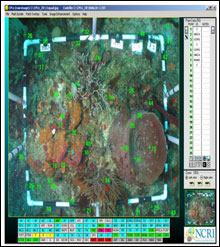 |
| Example of CPCe point count program. (Photo: National Coral Reef Institute) |
This information not only documents what organisms are in the image and how much area they cover but also allows the habitat to be classified. With the addition of the fish count data, scientists can examine how fish use habitat.
If you're interested in the free CPCe software go to: www.nova.edu/ocean/cpce.
. . . . . . . . . . . . .
Susie Holst, Program and Management Analyst
NOAA Coral Reef Conservation Program
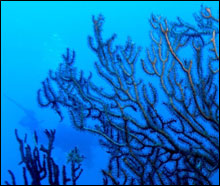 |
| Black coral. (Photo: NOAA CCFHR) |
The prospect of coming back out to the Dry Tortugas aboard the NOAA Ship Nancy Foster was a thrill when I first learned about this opportunity from John Burke, the mission's principle investigator, earlier this summer. It's a personal delight to be able to conduct scientific diving again on the beautiful coral reefs in the Dry Tortugas since I was involved with the original ground-truthing studies in 1999 to get the Tortugas Ecological Reserve designated. It's a treat to be able to see how this area has been doing since a decade ago -- and by all accounts, it seems that the Reserve is doing its job! It appears that the sites within the Reserve are showing higher fish abundances and the corals are doing well enough here to provide them with the right habitat. Now that I'm working with the NOAA Coral Reef Conservation Program I'm very interested in seeing how the management decisions made 10 years ago are effecting the coral reef ecosystem resources they were meant to protect -- and in the Dry Tortugas it appears to be working. The long-term monitoring done by the CCFHR team is giving us the evidence we need to say that the protected areas are successful. In this field where there is so much gloom and doom in the media it's nice to find some success stories, and I feel privileged to be able to take part in it with John and his dedicated, professional and highly competent team.
|



